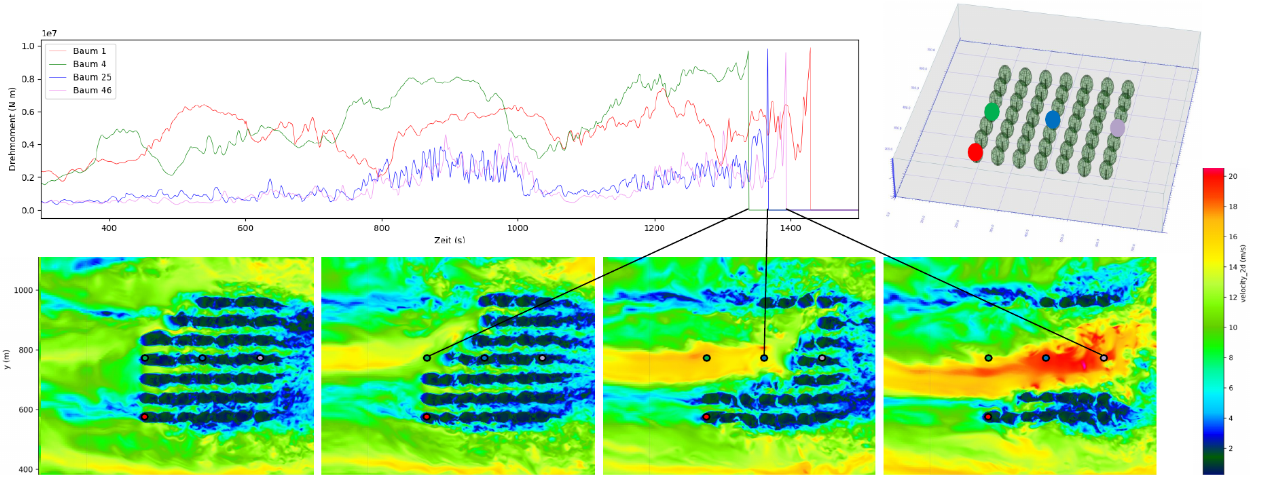| Version 2 (modified by westbrink, 3 years ago) (diff) |
|---|
WP-I6: A wind throw model for urban trees
Goals of the project:
Existing windthrow models from forest meteorology are being investigated with regard to their availability and applicability to urban trees. Such models as GALES or HWIND are based on findings from field trials and wind tunnel experiments on individual trees and are now used for extensive forest areas to estimate the storm risk. Meteorological input variables are always simple information, such as the mean wind at 10 m height outside the tree population. In an urban environment, on the other hand, wind and turbulence vary over a very short distance, and the forces on individual trees strongly depend on the location of the impact. The calculation of the windthrow risk for urban trees is to be carried out with a high spatial resolution of 1 m. Therefore, the detailed vegetation structures and the simulated high-resolution, locally strongly varying wind and turbulence fields are taken into account. In a first step, it will be investigated how the three-dimensional information from PALM-4U regarding the turbulent wind field can be taken into account in the existing windthrow models. Based on the results of these investigations, a windthrow model will be selected and implemented in PALM-4U in order to subsequently conduct sensitivity studies.
For the calculation of the risks of storms, individual parameters regarding the vegetation characteristics and the anchoring in the soil are of great importance. In a further step, the corresponding values compiled in the literature are processed and compiled in tabular form for typical urban trees. In order to determine the significance of individual input variables on the result, the influence of the range of these input data is calculated individually and in combination in a parameter study against the background of the individual uncertainties of the individual parameters. This result gives the This result gives decision-makers in the municipalities an indication of which data should be kept in the corresponding tree registers in order to be able to use PALM-4U for the investigation of the storm risk of urban trees. Possible extensions of the windthrow model for urban trees, such as the influence of tree vibrations, will be investigated and implemented if necessary.
To prove the realism of the implemented windthrow model, it will be applied to well-documented recent storm events, such as storm "Ela" in 2014 and storm "Xavier" in 2017, in which a very large number of trees were damaged and destroyed, especially in northern German cities. In addition to obtaining the building registers of the corresponding cities (for example Braunschweig for "Xavier"), the tree registers must be expanded to include the necessary input variables determined in WP-I6.2. The results of the simulations to be carried out are compared with the observed storm damage. Any differences that occur are analysed, appropriate modifications are made to the input data and the simulations are repeated.
Tasks of the project:
WP-I6.1: Einbau eines Windwurfmodells in PALM-4U
WP-I6.2: Erweiterung des Windwurfmodells und Parameterstudien
WP-I6.3: Die Anwendung des Windwurfmodells
Project structure:
Dieses Arbeitspaket wird von der LUH durchgeführt.
Deliverables:
DL1 (Monat 12): Windwurfmodell ist in PALM-4U implementiert
DL2 (Monat 24): Genauigkeit der benötigten Eingangsdaten für Stadtbäume ist bestimmt
DL3 (Monat 36): Werkzeug zur Bestimmung des Windwurfrisikos steht zur Verfügung
Progress so far:
Nach einer eingehenden Literaturrecherche wurde ein Windwurfmodell ausgewählt, dass auf dem Modell von Peltola and Kellomäki (1993) und Peltola et al. (1999) basiert und von Groß (2018) adaptiert wurde. Es wurde untersucht, wie das dreidimensionale turbulente Windfeld in PALM-4U auf dieses Modell angewendet werden kann und es wurde eine entsprechende Methodik und die dazu benötigten Algorithmen entwickelt. Das so adaptierte Windwurfmodell wurde schließlich in PALM-4U implementiert und getestet. Es wurde damit begonnen, die, für die Berechnung der Sturmgefährdung von Stadtbäumen benötigten Parameter zusammenzutragen und aufzubereiten. Diese Parameter werden benötigt, um mit PALM-4U eine realistische Untersuchung der Sturmgefahr von Stadtbäumen durchführen zu können.

Abbildung 1: In der Bildsequenz (30s Abstand) ist zu sehen, wie in einem idealisierten Setup (7x7 Raster) eine starke Böe 32 Bäume umwirft. Den Windschatten, den Baum 4 (grün) auf die dahinter stehenden Bäume 25 (blau) und 46 (violett) wirft, ist auch in der Darstellung des individuell an dem Bäumen wirkenden Verlauf des Drehmoments mit der Zeit gut zu erkennen.
References:
Peltola, H., & Kellomäki, S., (1993). A mechanistic model for calculating windthrow and stem breakage of Scots pines at stand age: Silva Fennica.
Peltola, H., Kellomäki, S., Väisänen, H., and Ikonen, V. -P., (1999) A mechanistic model for assessing the risk of wind and snow damage to single trees and stands of Scots pine, Norway spruce, and birch: Canadian Journal of Forest Research. 29(6): 647-661. https://doi.org/10.1139/x99-029.
Gross, G., (2018). A windthrow model for urban trees with application to storm "Xavier": Meteorologische Zeitschrift 27, Nr. 4, 27(4), 299-308. https://doi.org/10.1127/metz/2018/0905
Contacs:
gross[at]meteo.uni-hannover.de
knoop[at]meteo.uni-hannover.de
Attachments (1)
- windthrow.png (587.2 KB) - added by westbrink 3 years ago.
Download all attachments as: .zip



